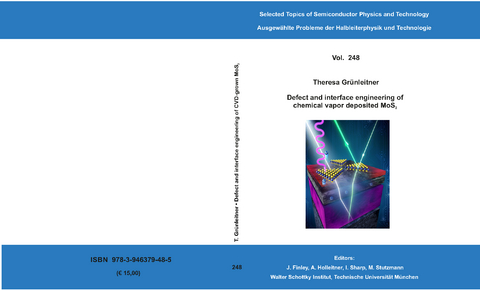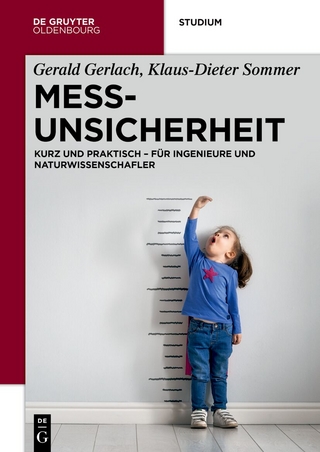Defect and interface engineering of chemical vapor deposited MoS2
Seiten
2023
Verein zur Förderung des Walter Schottky Instituts der Technischen Universität München (Verlag)
978-3-946379-48-5 (ISBN)
Verein zur Förderung des Walter Schottky Instituts der Technischen Universität München (Verlag)
978-3-946379-48-5 (ISBN)
- Titel nicht im Sortiment
- Artikel merken
The development of new materials is essential for meeting modern (opto)electronic device applications, including for down-scaling to the quantum limit and for driving green and sustainable technology for energy harvesting and storage. To achieve such goals, two dimensional (2D) materials are investigated because of their ultrathin nature, precisely tunable properties, and lack of dangling bonds, all of which make them highly suitable for myriad applications.
In this doctoral thesis, chemical vapor deposition (CVD) is established and optimized for fabrication of the 2D transition metal dichalcogenide (TMD) molybdenum disulfide (MoS2). Using this technique, we study the integration of MoS2 for large-scale device production with spatial control, develop a new thin film conductive support structure for improved optoelectronic performance, and modify the optoelectronic properties of MoS2 via deterministic defect generation for applications in photocatalysis and single photon emitters.
Firstly, we investigate the CVD growth mechanism in detail, which we use for site-selective growth of MoS2 on a patterned aluminum oxide/silicon dioxide (AlOx/SiO2) substrate. We show that we can tune the growth from in-plane mono- and multilayer MoS2 to out-ofplane MoO2/MoS2 core-shell structures. We find that site-selective growth is governed by the different surface free energies on laterally patterned substrates, with AlOx serving as a diffusion sink that enables preferential nucleation and growth. By investigating different gas phase environments during growth and examining the dominant diffusing species on the surface, we elucidate the underlying growth mechanisms of both in-plane MoS2 and out-ofplane MoO2/MoS2 in the used CVD growth configuration.
The influence of the substrate on MoS2 can not only be used for selective area growth, but also for engineering material properties and 2D-3D integration. Thus, we demonstrate the development of a transparent conductive thin film (TCF) consisting of a nanocrystalline carbon (nc-C)/AlOx layer. Following the fabrication process, we reveal the transformation of the evaporated carbon film to conductive nc-C upon high temperature annealing. This process is further compatible with direct CVD growth of MoS2 on the TCF. The good optical contrast of the underlying Si/SiO2 substrate is maintained for the TCF due to the transparency of the carbon and ultrathin AlOx layer. As possible applications, we demonstrate fast charge dissipation in scanning electron microscopy and X-ray photoemission electron microscopy experiments enabled by charge tunneling through the ultrathin AlOx. Optical characterization not only demonstrates good crystal quality of MoS2 directly grown on the TCF, but also a 10× PL enhancement due to low defect concentrations and shielding of dangling bonds of the underlying SiO2 substrate via the AlOx and the nc-C layer, respectively.
This TCF is subsequently used for the real time investigation of the generation of sulfur vacancies (SVs) using synchrotron radiation. Here, we see that for small and medium X-ray doses, we can locally generate monosulfur vacancies whereas for high doses, disulfur vacancies are created. Investigating the shift of the Fermi energy towards the valence band (VB) and new emerging states near the VB maximum, we find that SVs in MoS2 on the TCF lead to a lateral pn junction within the flake. These results are consistent with theory and support the claim that SVs are deep electron acceptors and not the cause for the intrinsic n-type conductivity in MoS2. Moreover, the passivation of SVs with in situ oxygen during XPS can be demonstrated, whereas SVs are metastable in air for at least a few minutes.
These results are the pathway for deterministic integration of 2D materials on a large scale as well as defect generation and passivation for highly efficient optoelectronic devices, quantum technology, and renewable energy storage.
In this doctoral thesis, chemical vapor deposition (CVD) is established and optimized for fabrication of the 2D transition metal dichalcogenide (TMD) molybdenum disulfide (MoS2). Using this technique, we study the integration of MoS2 for large-scale device production with spatial control, develop a new thin film conductive support structure for improved optoelectronic performance, and modify the optoelectronic properties of MoS2 via deterministic defect generation for applications in photocatalysis and single photon emitters.
Firstly, we investigate the CVD growth mechanism in detail, which we use for site-selective growth of MoS2 on a patterned aluminum oxide/silicon dioxide (AlOx/SiO2) substrate. We show that we can tune the growth from in-plane mono- and multilayer MoS2 to out-ofplane MoO2/MoS2 core-shell structures. We find that site-selective growth is governed by the different surface free energies on laterally patterned substrates, with AlOx serving as a diffusion sink that enables preferential nucleation and growth. By investigating different gas phase environments during growth and examining the dominant diffusing species on the surface, we elucidate the underlying growth mechanisms of both in-plane MoS2 and out-ofplane MoO2/MoS2 in the used CVD growth configuration.
The influence of the substrate on MoS2 can not only be used for selective area growth, but also for engineering material properties and 2D-3D integration. Thus, we demonstrate the development of a transparent conductive thin film (TCF) consisting of a nanocrystalline carbon (nc-C)/AlOx layer. Following the fabrication process, we reveal the transformation of the evaporated carbon film to conductive nc-C upon high temperature annealing. This process is further compatible with direct CVD growth of MoS2 on the TCF. The good optical contrast of the underlying Si/SiO2 substrate is maintained for the TCF due to the transparency of the carbon and ultrathin AlOx layer. As possible applications, we demonstrate fast charge dissipation in scanning electron microscopy and X-ray photoemission electron microscopy experiments enabled by charge tunneling through the ultrathin AlOx. Optical characterization not only demonstrates good crystal quality of MoS2 directly grown on the TCF, but also a 10× PL enhancement due to low defect concentrations and shielding of dangling bonds of the underlying SiO2 substrate via the AlOx and the nc-C layer, respectively.
This TCF is subsequently used for the real time investigation of the generation of sulfur vacancies (SVs) using synchrotron radiation. Here, we see that for small and medium X-ray doses, we can locally generate monosulfur vacancies whereas for high doses, disulfur vacancies are created. Investigating the shift of the Fermi energy towards the valence band (VB) and new emerging states near the VB maximum, we find that SVs in MoS2 on the TCF lead to a lateral pn junction within the flake. These results are consistent with theory and support the claim that SVs are deep electron acceptors and not the cause for the intrinsic n-type conductivity in MoS2. Moreover, the passivation of SVs with in situ oxygen during XPS can be demonstrated, whereas SVs are metastable in air for at least a few minutes.
These results are the pathway for deterministic integration of 2D materials on a large scale as well as defect generation and passivation for highly efficient optoelectronic devices, quantum technology, and renewable energy storage.
| Erscheinungsdatum | 26.08.2023 |
|---|---|
| Sprache | englisch |
| Maße | 150 x 210 mm |
| Themenwelt | Naturwissenschaften ► Physik / Astronomie |
| Schlagworte | 2D Materials • Chemical vapor deposition • MoS2 |
| ISBN-10 | 3-946379-48-6 / 3946379486 |
| ISBN-13 | 978-3-946379-48-5 / 9783946379485 |
| Zustand | Neuware |
| Haben Sie eine Frage zum Produkt? |
Mehr entdecken
aus dem Bereich
aus dem Bereich
von den Werkzeugen über Methoden zum TQM
Buch | Softcover (2024)
Springer Fachmedien (Verlag)
32,99 €
kurz und praktisch - für Ingenieure und Naturwissenschafler
Buch | Softcover (2024)
De Gruyter Oldenbourg (Verlag)
44,95 €




